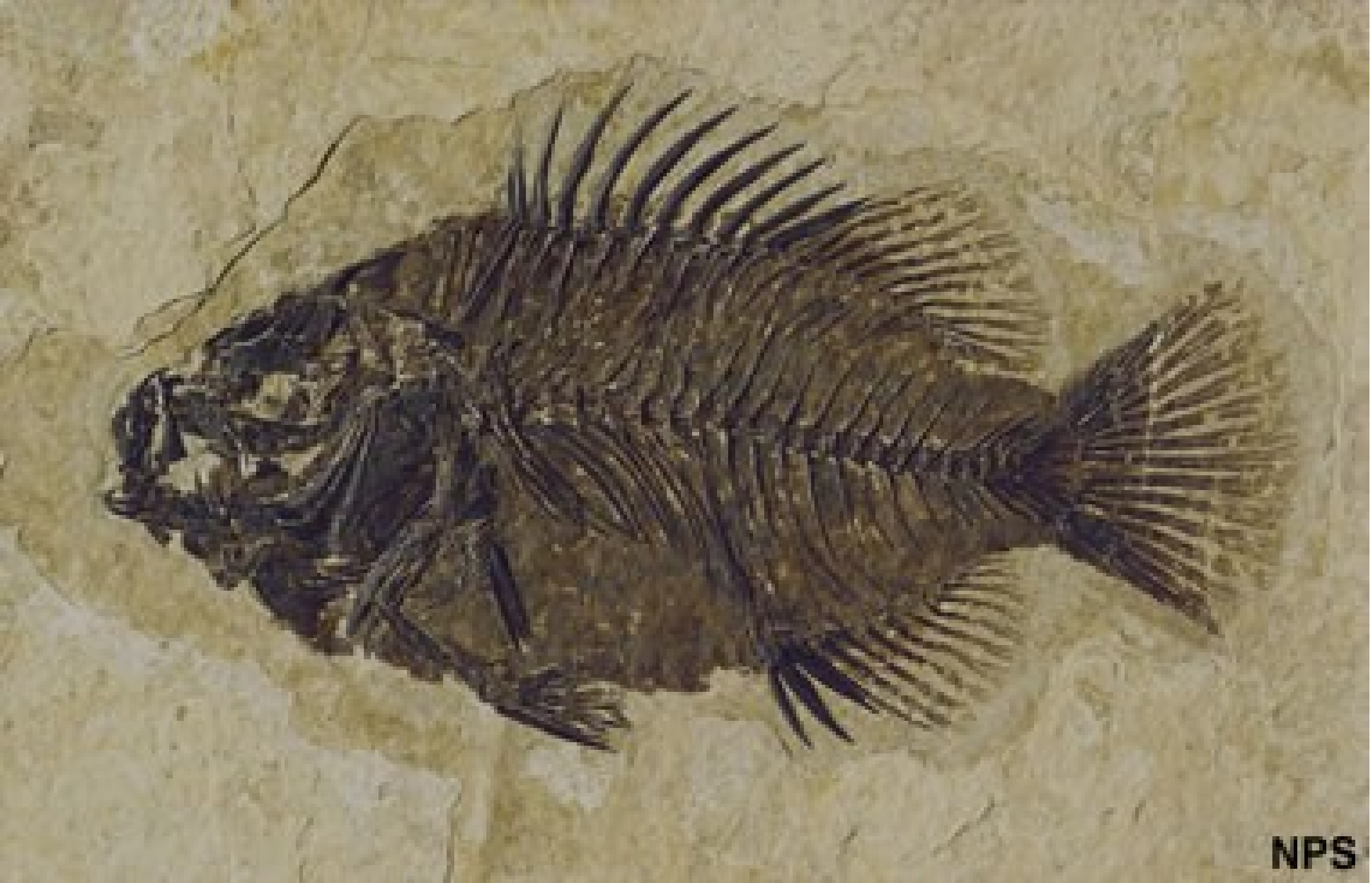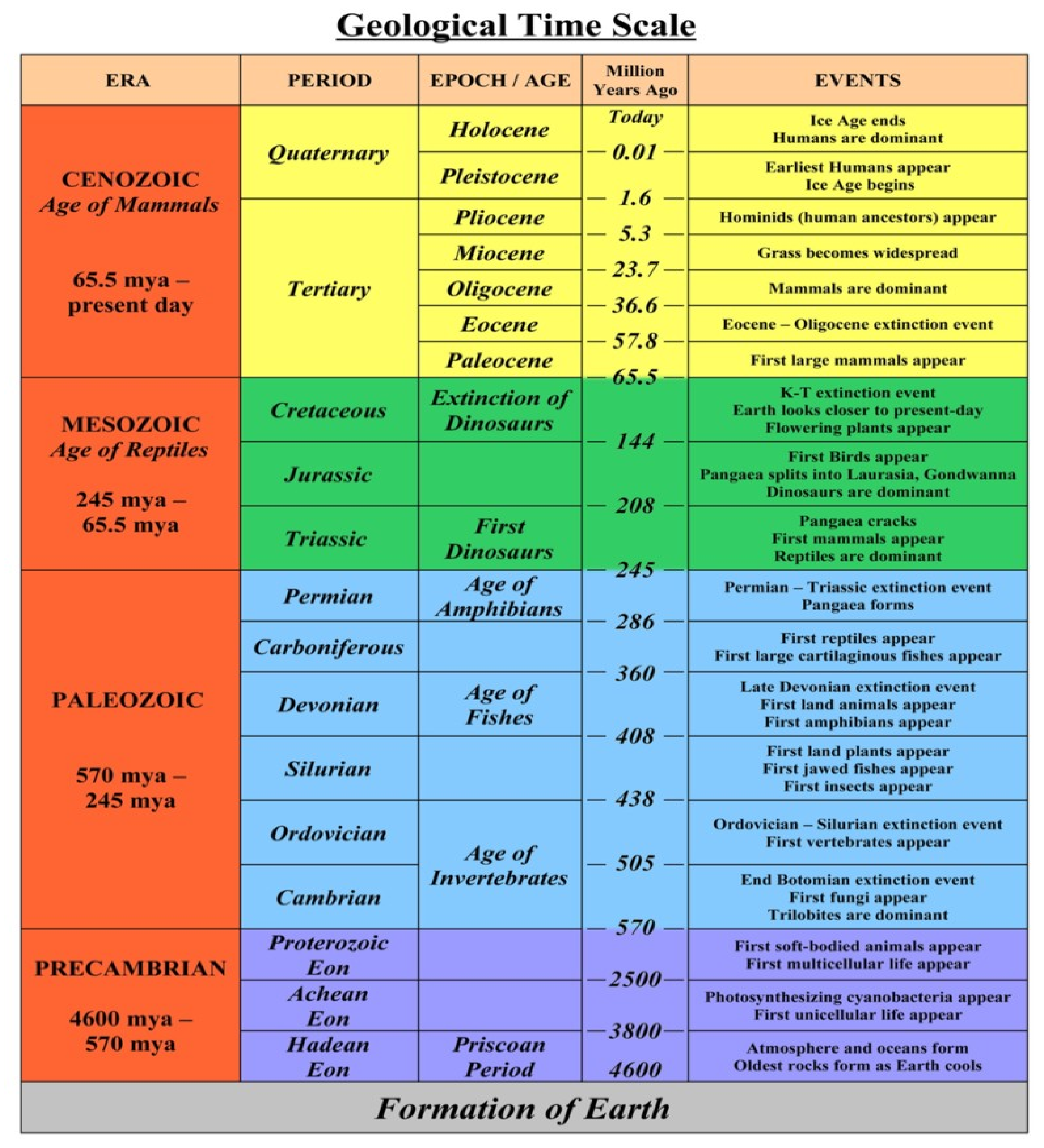Section 11.5 Historical Geology


Fossils1
geology.com/fossils/Paleontologists study fossils to understand the history of life on Earth. They analyze the physical remains of organisms that lived in the past, such as bones, teeth, shells, and plant impressions. Fossils preserved remains or traces of past organisms that can be used to study geological events on the earth. Radiometric dating method is used to determine the age of rocks, fossils, and other geological events. By using the radiometric dating geologists are able to determine the last 542 million years of Earth’s history as the Phanerozoic eon, which is divided into three eras: the Paleozoic, the Mesozoic, and the Cenozoic.
- The Cenozoic era is the most recent era of Earth’s history, following the Mesozoic era and spanning from 66 million years ago to the present day. It is divided into three periods: the Paleogene, the Neogene, and the Quaternary. During the Cenozoic era, the Earth underwent significant changes, including the evolution of mammals and the emergence of modern humans. The Paleogene period saw the rise of mammals after the extinction of the dinosaurs, with many groups diversifying and evolving to occupy new ecological niches. The Neogene period saw the diversification of grasses and the evolution of many modern plant and animal groups. Finally, the Quaternary period saw the evolution of modern humans and the development of human societies.
- The Mesozoic era is the era of geological time that spans from about 252 to 66 million years ago. It is also referred to as the Age of Reptiles because dinosaurs, pterosaurs, and marine reptiles dominated the planet during this time. The Mesozoic era is divided into three periods: the Triassic, Jurassic, and Cretaceous. During the Triassic period, life on land began to recover from the Permian-Triassic extinction event, which had wiped out about 96% of marine species and 70% of terrestrial vertebrate species. During the Jurassic period, dinosaurs became more dominant, and the first birds evolved. The Cretaceous period saw the evolution of many new types of dinosaurs, including the tyrannosaurs and the ceratopsians. The end of the Mesozoic era is marked by the Cretaceous-Paleogene extinction event, which wiped out the dinosaurs and many other species. This event has been dated to about 66 million years ago using radiometric dating, and it is thought to have been caused by a massive asteroid impact. The extinction of the dinosaurs paved the way for the evolution of mammals and ultimately led to the emergence of modern terrestrial ecosystems.
- The Paleozoic era is a geological era that spanned from about 541 to 252 million years ago. It is the earliest era of the Phanerozoic eon, and it is divided into six periods: the Cambrian, Ordovician, Silurian, Devonian, Carboniferous, and Permian periods. The Paleozoic era is characterized by significant geological and biological changes, including the emergence of complex multicellular life, the development of hard shells and skeletons, and the evolution of early fish, plants, and insects. The Cambrian explosion, which occurred during the Cambrian period, marked a rapid diversification of animal life, including the first appearance of many modern phyla. During the Paleozoic era, Earth’s continents were united in the supercontinent of Pangaea, which began to break up during the Mesozoic era. The Paleozoic era ended with the Permian extinction event, which wiped out about 95% of marine species and 70% of terrestrial species. The cause of this extinction event is still debated, but it is thought to have been caused by a combination of volcanic activity, climate change, and asteroid impacts.
An eon is a geological time Figure 11.5.2 unit that represents a span of billions of years. The history of the Earth is divided into four eons: the Hadean, Archean, Proterozoic, and Phanerozoic eons. The Hadean eon represents the earliest period of Earth’s history, from the formation of the planet about 4.6 billion years ago to about 4 billion years ago. The Hadean eon is characterized by intense volcanic activity, meteorite impacts, and the formation of the Earth’s atmosphere and oceans. The Archean eon follows the Hadean eon and spans from about 4 billion to 2.5 billion years ago. During the Archean eon, the first life forms evolved, including the earliest prokaryotic cells. The Proterozoic eon follows the Archean eon and spans from about 2.5 billion to 541 million years ago. During the Proterozoic eon, the first eukaryotic cells and multicellular organisms evolved, and oxygen levels in the atmosphere rose significantly. The Phanerozoic eon is the most recent eon and spans from about 541 million years ago to the present day. The Phanerozoic eon is divided into three eras: the Paleozoic, Mesozoic, and Cenozoic eras. During the Phanerozoic eon, complex life forms, such as fishes, amphibians, reptiles, mammals, and birds, evolved and diversified, and the Earth underwent significant geological changes, such as the formation and breakup of supercontinents.
Precambrian time: The Precambrian is a geological eon that spans from about 4.6 billion years ago to approximately 541 million years ago, which is the beginning of the Phanerozoic eon. It is divided into three eras: the Hadean, the Archean, and the Proterozoic. During the Hadean era, the Earth was formed and underwent intense geological activity, including volcanic eruptions, meteorite impacts, and the formation of the oceans and atmosphere. The first life forms may have emerged during this time. The Archean era saw the emergence of the first prokaryotic cells, as well as the formation of the continents and the stabilization of the Earth’s crust. Cyanobacteria, which are photosynthetic bacteria, also emerged during this era and started to produce oxygen, which changed the composition of the atmosphere. The Proterozoic era saw the emergence of eukaryotic cells, which have a nucleus and other organelles, as well as the evolution of multicellular organisms. This era also saw the development of complex ecosystems and the first appearance of animals.

Geological History2
quizlet.com/260294732/geologic-time-scale-diagram/Here are the time spans in chronological order from largest to smallest:
- Eon - a division of geological time that spans billions of years.
- Era - a subdivision of an eon that is characterized by significant changes in the Earth’s climate, geography, and life forms.
- Period - a subdivision of an era that is characterized by distinct rock layers and identifiable changes in the fossil record.
- Epoch - a subdivision of a period that is characterized by smaller-scale changes in the fossil record and other geological features.
